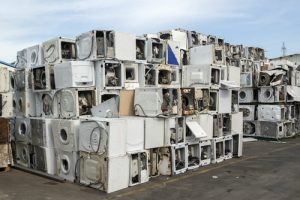 A European project will release a data platform providing a wealth of information on changes in the end-of-life stream. The particulars can help processors better recover commodities from scrap electronics.
A European project will release a data platform providing a wealth of information on changes in the end-of-life stream. The particulars can help processors better recover commodities from scrap electronics.

 A European project will release a data platform providing a wealth of information on changes in the end-of-life stream. The particulars can help processors better recover commodities from scrap electronics.
A European project will release a data platform providing a wealth of information on changes in the end-of-life stream. The particulars can help processors better recover commodities from scrap electronics.
 A new phone gets a rock-bottom score when it comes to repairability, and a Kansas program finds a creative way to reuse scrap electronic components.
A new phone gets a rock-bottom score when it comes to repairability, and a Kansas program finds a creative way to reuse scrap electronic components.
DataSavers of Jacksonville, Fla.; E-Waste Security of Irvine, Calif.; Jabil of Memphis, Tenn.; Rapid Shred of Grandville, Mich.; Shred Doc Destr dba Balcones Shred of Austin, Texas; Shred-Ex of Colchester, Vt. and Shred Masters of South Ogden, Utah have either achieved or renewed their NAID certifications for physical destruction of hard drives.
Visit our archive to view previous editions of the scorecard.
 Almost all survey respondents in China say they’re storing unwanted electronics, and a study shows explosive growth in the generation of scrap phones and computers in India.
Almost all survey respondents in China say they’re storing unwanted electronics, and a study shows explosive growth in the generation of scrap phones and computers in India.
 With E-Scrap 2017 fast approaching, we’ve been highlighting a few of the experts who will share their insights on stage in Orlando. With less than a week to go, we’re offering our final interview, with Sarah Downes.
With E-Scrap 2017 fast approaching, we’ve been highlighting a few of the experts who will share their insights on stage in Orlando. With less than a week to go, we’re offering our final interview, with Sarah Downes.
 Seven e-scrap entities have been accused of questionable downstream practices by the Basel Action Network, after tracking devices showed they were involved in moving materials that were eventually exported to developing countries.
Seven e-scrap entities have been accused of questionable downstream practices by the Basel Action Network, after tracking devices showed they were involved in moving materials that were eventually exported to developing countries.
 Though overall revenue fell, profits at global e-scrap company Sims Recycling Solutions grew significantly last year, according to the firm’s latest financial filings.
Though overall revenue fell, profits at global e-scrap company Sims Recycling Solutions grew significantly last year, according to the firm’s latest financial filings.
 A lawsuit accuses Closed Loop Refining and Recovery, Kuusakoski, and UNICOR of being responsible for a “sham recycling scheme” that led to the abandonment of over 100 million pounds of CRT material in Columbus, Ohio.
A lawsuit accuses Closed Loop Refining and Recovery, Kuusakoski, and UNICOR of being responsible for a “sham recycling scheme” that led to the abandonment of over 100 million pounds of CRT material in Columbus, Ohio.
 A unique, non-toxic leaching technology that’s been deployed in Canada is set to roll out at the site of an electronics manufacturer in Tennessee.
A unique, non-toxic leaching technology that’s been deployed in Canada is set to roll out at the site of an electronics manufacturer in Tennessee.
 A number of CRT-related updates, including an $18 million judgment in a lawsuit against one firm, drew our readers’ clicks in August.
A number of CRT-related updates, including an $18 million judgment in a lawsuit against one firm, drew our readers’ clicks in August.
